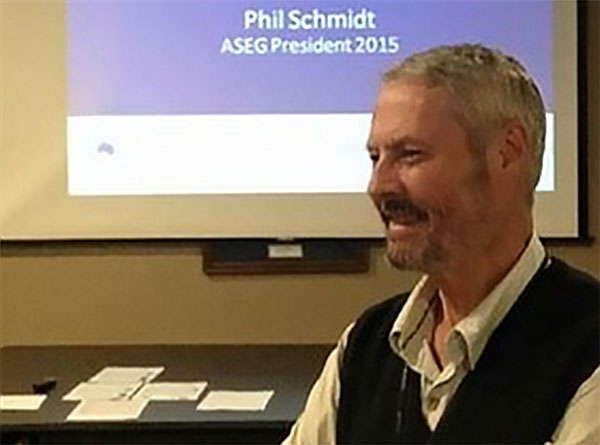Back in the late 1960s, when Australia was hopping off the sheep’s back and onto a drilling rig, geologists were in high demand. A discovery by Poseidon Nickel of what was thought to be a lucrative deposit famously sent mining shares in the Australian company skyrocketing on the London stock exchange.
But, as Phil Schmidt was to learn throughout his career, mineral exploration is prone to dramatic and often unpredictable cycles. “By the time I graduated from UNE, with an Honours degree in Science in 1972, Poseidon shares had crashed,” he said. “Exploration and the price of resources have been cyclical ever since.”
Still, UNE’s Geology Department was “as good as anywhere in the world” to learn about the Earth’s potential, and Earle Page College became home for most of Phil’s studies. After completing a PhD at ANU, he then embarked on his geophysics career with big dreams.
“I thought I would be travelling the outback and working for companies, making decisions on where to put drill holes, that sort of thing. That’s what I was trained for. As it turned out, I ended up travelling around Australia, drilling rocks myself and taking samples back to a CSIRO laboratory.”
By then another minerals cycle had come and gone. But at CSIRO, where Phil worked for 34 years and rose to the position of Chief Research Scientist Geophysics, he was somewhat shielded from market vagaries. “Ironically, we found there was more money available for research during the downtimes,” he said.
Phil’s early work at CSIRO focussed on collecting samples nationwide to develop foundational datasets for the magnetic properties of our rocks and exploring what they could tell us about the subsurface. He was first introduced to rock magnetism/palaeomagnetism by Professor Ron Green during his Honours year at UNE.
“The staff of the UNE Geology Department were world-class.”
“He very much encouraged me to think outside the square and suggested I carry on my research,” Phil said. “The staff of the UNE Geology Department were world-class.”
Phil’s subsequent leading-edge research into applied magnetics sustained his career and, post-retirement in 2012, inspired the development of a portable field magnetometer (the Q-Meter) for measuring the magnetic signatures of rocks. For in minerals exploration, where multi-millions of dollars can be at stake, interpretation of the survey and the location of magnetic targets is often compromised because the rock magnetism is unknown.
“We were typically getting samples from companies who had just withdrawn their drilling rig and gone away, believing they had missed the target and that the rocks they brought up in the drill core were not magnetic,” Phillip explains. “That’s because the instruments they had measured induced magnetisation but didn’t measure remanent, or permanent magnetisation. So they walked away and, in some cases, let the lease go to someone else. The Q-Meter overcame that magnetism measurement issue.”
Last year, Phillip’s contributions to the science and practice of geophysics and, by default the mining industry, earned him a gold medal from the Australian Society of Exploration Geophysicists (ASEG). The award recognised “Phil’s exceptional and distinguished contributions to the science and practice of geophysics in Australia and internationally, through his leading-edge research and developments in the theory and practical application of rock magnetism/palaeomagnetism, and for his significant contributions to the ASEG over many years”.
That contribution to Australian earth sciences, and to the education of students and working explorationists, has at times been very deep, literally. “One of my underlying research projects was to try to understand the geological history of the Earth as a whole, particularly continental drift and seafloor spreading,” Phil said. “The ultimate goal was to understand the internal mechanisms of the earth and that, in itself, is now becoming very important because those mechanisms are driving a lot of the mineralisation in the deeper crust.
“Rocks, and when they are magnetised and remagnetised, are a recording medium for our geological history,” said Phil. And in the current quest for critical minerals long overlooked but now vital to our electrification future, geology is again enjoying a moment.
“These solar and electric vehicle-related minerals will drive things for quite a long cycle, I imagine, and the irony is that universities are cutting back on their earth sciences,” Phil said. “It underlines the importance of curiosity-driven research – the kind of research when the scientist knows there is something important about a particular subject or inquiry, but no-one is going to pay them because it might turn into nothing. The flip side is that such research might turn into something big.”


